Abstract
Nine participants outlined findings in the area of neurobehavioral effects of dioxin-like compounds and presented plans for new studies. Neurobehavioral effects are among the most sensitive and well studied toxicity end points for this class of compounds. A focus of the workshop was presentation of designs for major new studies in human populations outside the United States that are intended to extend and clarify the results of two previous large-scale studies in populations in Michigan and North Carolina. Improved methods for exposure assessment and more focused approaches to understanding specific neurobehavioral deficits were highlighted. Animal studies and in vitro mechanistic studies are emphasizing the importance of alterations in neurotransmitter systems and thyroid function that may underlie behavioral dysfunction. There is continuing improvement in analytical and study design methods to identify the most active congeners of PCB mixtures in the environment. These diverse studies will contribute to effective response of public health and regulatory groups to this continuing problem.
Full text
PDF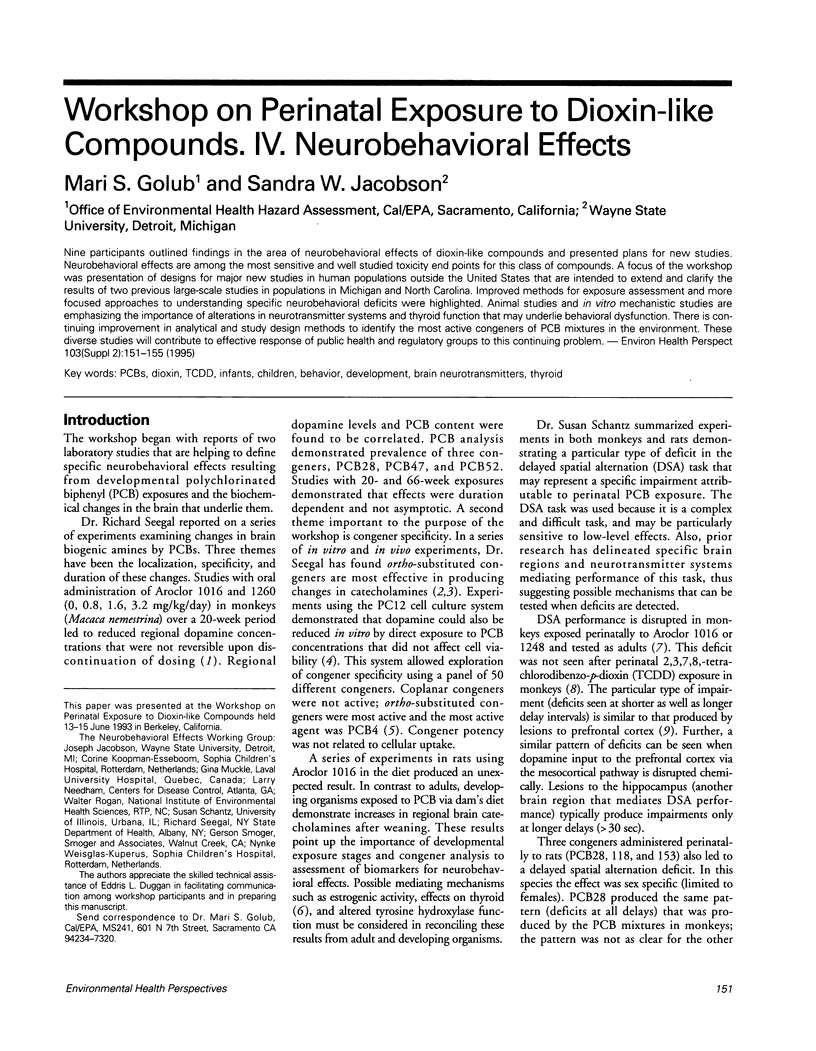
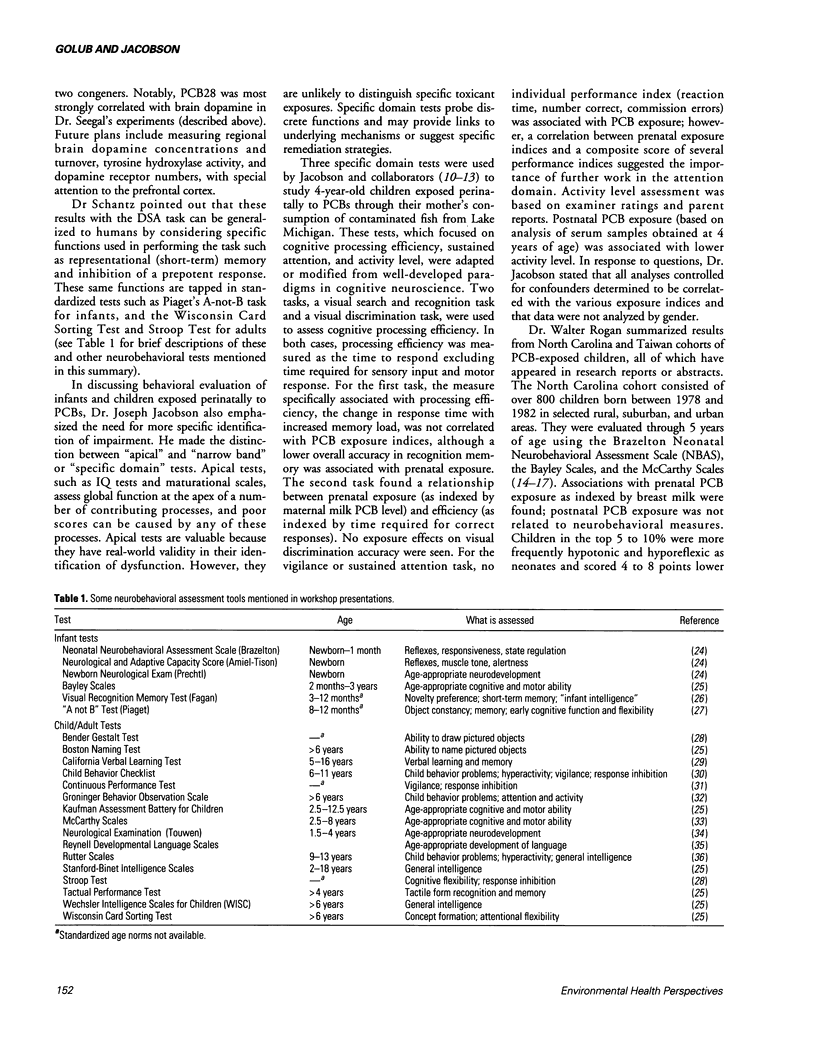
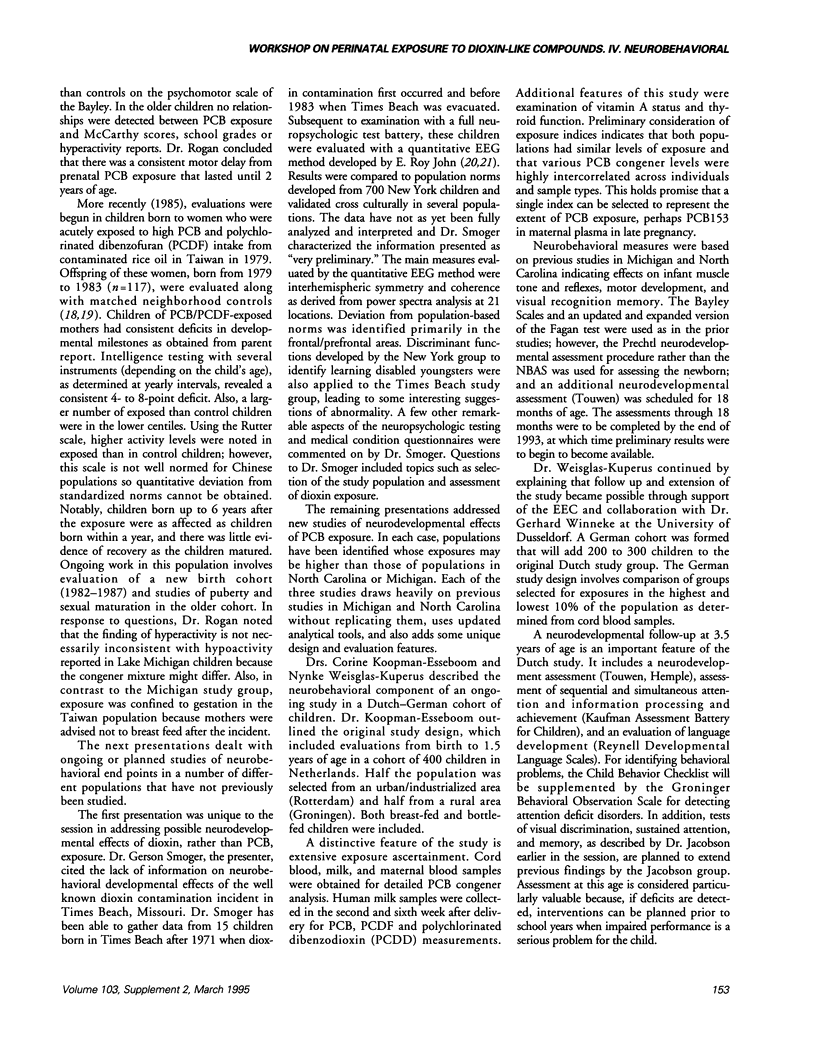
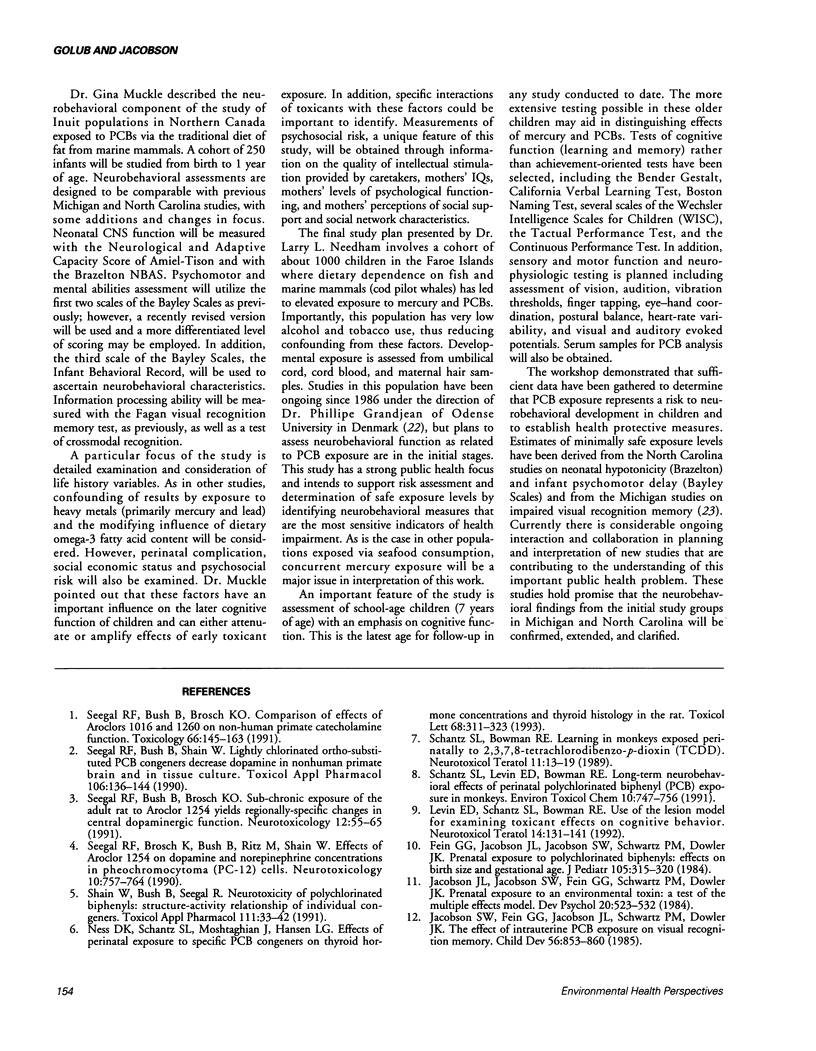
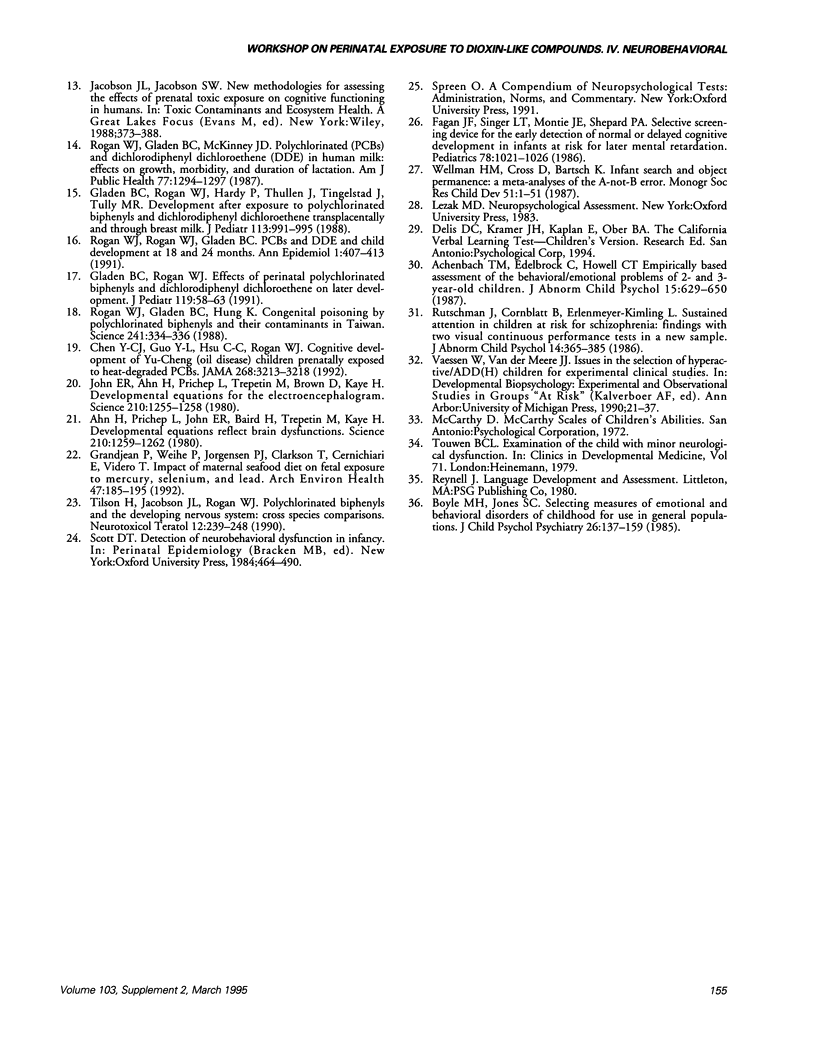
Selected References
These references are in PubMed. This may not be the complete list of references from this article.
- Achenbach T. M., Edelbrock C., Howell C. T. Empirically based assessment of the behavioral/emotional problems of 2- and 3- year-old children. J Abnorm Child Psychol. 1987 Dec;15(4):629–650. doi: 10.1007/BF00917246. [DOI] [PubMed] [Google Scholar]
- Ahn H., Prichep L., John E. R., Baird H., Trepetin M., Kaye H. Developmental equations reflect brain dysfunctions. Science. 1980 Dec 12;210(4475):1259–1262. doi: 10.1126/science.7434027. [DOI] [PubMed] [Google Scholar]
- Boyle M. H., Jones S. C. Selecting measures of emotional and behavioral disorders of childhood for use in general populations. J Child Psychol Psychiatry. 1985 Jan;26(1):137–159. doi: 10.1111/j.1469-7610.1985.tb01634.x. [DOI] [PubMed] [Google Scholar]
- Chen Y. C., Guo Y. L., Hsu C. C., Rogan W. J. Cognitive development of Yu-Cheng ("oil disease") children prenatally exposed to heat-degraded PCBs. JAMA. 1992 Dec 9;268(22):3213–3218. [PubMed] [Google Scholar]
- Fagan J. F., 3rd, Singer L. T., Montie J. E., Shepherd P. A. Selective screening device for the early detection of normal or delayed cognitive development in infants at risk for later mental retardation. Pediatrics. 1986 Dec;78(6):1021–1026. [PubMed] [Google Scholar]
- Fein G. G., Jacobson J. L., Jacobson S. W., Schwartz P. M., Dowler J. K. Prenatal exposure to polychlorinated biphenyls: effects on birth size and gestational age. J Pediatr. 1984 Aug;105(2):315–320. doi: 10.1016/s0022-3476(84)80139-0. [DOI] [PubMed] [Google Scholar]
- Gladen B. C., Rogan W. J. Effects of perinatal polychlorinated biphenyls and dichlorodiphenyl dichloroethene on later development. J Pediatr. 1991 Jul;119(1 Pt 1):58–63. doi: 10.1016/s0022-3476(05)81039-x. [DOI] [PubMed] [Google Scholar]
- Gladen B. C., Rogan W. J., Hardy P., Thullen J., Tingelstad J., Tully M. Development after exposure to polychlorinated biphenyls and dichlorodiphenyl dichloroethene transplacentally and through human milk. J Pediatr. 1988 Dec;113(6):991–995. doi: 10.1016/s0022-3476(88)80569-9. [DOI] [PubMed] [Google Scholar]
- Grandjean P., Weihe P., Jørgensen P. J., Clarkson T., Cernichiari E., Viderø T. Impact of maternal seafood diet on fetal exposure to mercury, selenium, and lead. Arch Environ Health. 1992 May-Jun;47(3):185–195. doi: 10.1080/00039896.1992.9938348. [DOI] [PubMed] [Google Scholar]
- Jacobson S. W., Fein G. G., Jacobson J. L., Schwartz P. M., Dowler J. K. The effect of intrauterine PCB exposure on visual recognition memory. Child Dev. 1985 Aug;56(4):853–860. [PubMed] [Google Scholar]
- John E. R., Ahn H., Prichep L., Trepetin M., Brown D., Kaye H. Developmental equations for the electroencephalogram. Science. 1980 Dec 12;210(4475):1255–1258. doi: 10.1126/science.7434026. [DOI] [PubMed] [Google Scholar]
- Levin E. D., Schantz S. L., Bowman R. E. Use of the lesion model for examining toxicant effects on cognitive behavior. Neurotoxicol Teratol. 1992 Mar-Apr;14(2):131–141. doi: 10.1016/0892-0362(92)90061-e. [DOI] [PubMed] [Google Scholar]
- Ness D. K., Schantz S. L., Moshtaghian J., Hansen L. G. Effects of perinatal exposure to specific PCB congeners on thyroid hormone concentrations and thyroid histology in the rat. Toxicol Lett. 1993 Jun;68(3):311–323. doi: 10.1016/0378-4274(93)90023-q. [DOI] [PubMed] [Google Scholar]
- Rogan W. J., Gladen B. C., Hung K. L., Koong S. L., Shih L. Y., Taylor J. S., Wu Y. C., Yang D., Ragan N. B., Hsu C. C. Congenital poisoning by polychlorinated biphenyls and their contaminants in Taiwan. Science. 1988 Jul 15;241(4863):334–336. doi: 10.1126/science.3133768. [DOI] [PubMed] [Google Scholar]
- Rogan W. J., Gladen B. C., McKinney J. D., Carreras N., Hardy P., Thullen J., Tingelstad J., Tully M. Polychlorinated biphenyls (PCBs) and dichlorodiphenyl dichloroethene (DDE) in human milk: effects on growth, morbidity, and duration of lactation. Am J Public Health. 1987 Oct;77(10):1294–1297. doi: 10.2105/ajph.77.10.1294. [DOI] [PMC free article] [PubMed] [Google Scholar]
- Rogan W. J., Gladen B. C. PCBs, DDE, and child development at 18 and 24 months. Ann Epidemiol. 1991 Aug;1(5):407–413. doi: 10.1016/1047-2797(91)90010-a. [DOI] [PubMed] [Google Scholar]
- Rutschmann J., Cornblatt B., Erlenmeyer-Kimling L. Sustained attention in children at risk for schizophrenia: findings with two visual continuous performance tests in a new sample. J Abnorm Child Psychol. 1986 Sep;14(3):365–385. doi: 10.1007/BF00915432. [DOI] [PubMed] [Google Scholar]
- Schantz S. L., Bowman R. E. Learning in monkeys exposed perinatally to 2,3,7,8-tetrachlorodibenzo-p-dioxin (TCDD). Neurotoxicol Teratol. 1989 Jan-Feb;11(1):13–19. doi: 10.1016/0892-0362(89)90080-9. [DOI] [PubMed] [Google Scholar]
- Seegal R. F., Brosch K., Bush B., Ritz M., Shain W. Effects of Aroclor 1254 on dopamine and norepinephrine concentrations in pheochromocytoma (PC-12) cells. Neurotoxicology. 1989 Winter;10(4):757–764. [PubMed] [Google Scholar]
- Seegal R. F., Bush B., Brosch K. O. Comparison of effects of Aroclors 1016 and 1260 on non-human primate catecholamine function. Toxicology. 1991 Feb;66(2):145–163. doi: 10.1016/0300-483x(91)90215-m. [DOI] [PubMed] [Google Scholar]
- Seegal R. F., Bush B., Brosch K. O. Sub-chronic exposure of the adult rat to Aroclor 1254 yields regionally-specific changes in central dopaminergic function. Neurotoxicology. 1991 Spring;12(1):55–65. [PubMed] [Google Scholar]
- Seegal R. F., Bush B., Shain W. Lightly chlorinated ortho-substituted PCB congeners decrease dopamine in nonhuman primate brain and in tissue culture. Toxicol Appl Pharmacol. 1990 Oct;106(1):136–144. doi: 10.1016/0041-008x(90)90113-9. [DOI] [PubMed] [Google Scholar]
- Shain W., Bush B., Seegal R. Neurotoxicity of polychlorinated biphenyls: structure-activity relationship of individual congeners. Toxicol Appl Pharmacol. 1991 Oct;111(1):33–42. doi: 10.1016/0041-008x(91)90131-w. [DOI] [PubMed] [Google Scholar]
- Tilson H. A., Jacobson J. L., Rogan W. J. Polychlorinated biphenyls and the developing nervous system: cross-species comparisons. Neurotoxicol Teratol. 1990 May-Jun;12(3):239–248. doi: 10.1016/0892-0362(90)90095-t. [DOI] [PubMed] [Google Scholar]
- Wellman H. M., Cross D., Bartsch K. Infant search and object permanence: a meta-analysis of the A-not-B error. Monogr Soc Res Child Dev. 1987;51(3):1–67. [PubMed] [Google Scholar]


